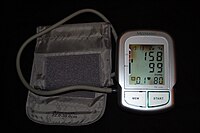
Photo from wikipedia
© American Federation for Medical Research 2021. No commercial reuse. See rights and permissions. Published by BMJ. Pulmonary arterial hypertension (PAH) diagnosis and management have evolved over the years. Despite… Click to show full abstract
© American Federation for Medical Research 2021. No commercial reuse. See rights and permissions. Published by BMJ. Pulmonary arterial hypertension (PAH) diagnosis and management have evolved over the years. Despite advances in management that resulted in an overall improvement of disease outcomes, there remain challenges to be addressed, including more accurate disease phenotyping, earlier diagnosis with better screening, and novel therapeutic approaches. In this issue of the Journal of Investigative Medicine, Deshwal review the changing landscape of PAH with a special emphasis on clinical risk assessment as a tool to guide treatment options. Further disease phenotyping is needed beyond the current Sixth World Symposium on Pulmonary Hypertension subgroups to better understand the disease and response to therapies. The Redefining Pulmonary Hypertension through Pulmonary Vascular Disease Phenomics program aims to compare ‘omics’ data to better phenotype patients with pulmonary vascular disease to advance a precision medicine approach. 4 The lack of consistent response to multiple PAHspecific therapies across the PAH spectrum may be due to our lack of complete understanding of the heterogeneity of patients with PAH and disease subtypes. Using omics approaches to predict treatment responders would go a long way to increasing the benefit of drug treatment while limiting adverse effects. Earlier diagnosis and referral to specialized pulmonary hypertension centers is still a challenge. A significant number of patients with PAH have symptoms for >2 years before diagnosis. Furthermore, the mean pulmonary artery pressure among the participants in the ABMITION trial, which focused on incident PAH, was about 49 mm Hg, reflecting a missed gap for earlier diagnosis. One barrier to earlier diagnosis is the nonspecific symptoms associated with PAH onset which overlap with symptoms of other cardiopulmonary diseases. Recent advances in MRI using hyperpolarized Xe gas and dynamic spectroscopy showed promising results with the ability to identify unique signatures for PAH, chronic obstructive pulmonary disease, idiopathic pulmonary fibrosis, and left heart failure, and have the potential to be used as a possible noninvasive sensitive probe for earlier diagnosis. Deshwal correctly point out that PAH risk stratification is a powerful management tool that is still underutilized partly due to the multitude and complexity of scoring systems. REVEAL Lite 2, an abridged version of REVEAL 2.0, may mitigate some potential barriers of risk assessment in clinical practice by only using six noninvasive modifiable variables that include functional class, 6 min walk distance, brain natriuretic peptide/Nterminal prohormone of brain natriuretic peptide level, vital signs (systolic blood pressure and heart rate), and renal insufficiency. Including right ventricular imaging data may augment current risk scores as these can possibly predict disease progression in seemingly clinically stable patients. More recently, risk stratification using Bayesian analysis was used to develop the Pulmonary Hypertension Outcomes Risk Assessment with improved discrimination of risk stratification that outperformed REVEAL 2.0. Risk stratification strategy can inform PAH clinical trials to ensure balanced randomization, to serve as a meaningful primary end point, and to help clinical trials enrichment to reduce sample size, trial length, and cost. The area of therapeutics continues to evolve with several advances in treatment options and delivery methods. Intravenous selexipag was recently approved as a bridge for patients on oral selexipag who are temporarily unable to take oral therapy. A fully implantable system for treprostinil delivery can potentially improve the quality of life of patients with PAH. INSPIRE and BREEZE trials (NCT03950739) are offering inhaled treprostinil in a dry powder formulation through newer delivery systems that are more portable and convenient to patients with PAH. A phase II/III study is currently evaluating a oncedaily inhaled soluble guanylate cyclase stimulator (MK-5475007) in patients with PAH (NCT04732221). The Remunity pump is a new delivery system for subcutaneous treprostinil that uses prefilled disposable cassettes with several safety features. As highlighted by Deshwal, sotatercept is a step forward on the right path to target novel treatment pathways in PAH. Finally, despite the advances in therapy and delivery systems, treatments that target the right ventricle to improve its function are urgently needed as the right ventricular function is a major determinant of PAH outcome.
Journal Title: Journal of Investigative Medicine
Year Published: 2021
Link to full text (if available)
Share on Social Media: Sign Up to like & get
recommendations!